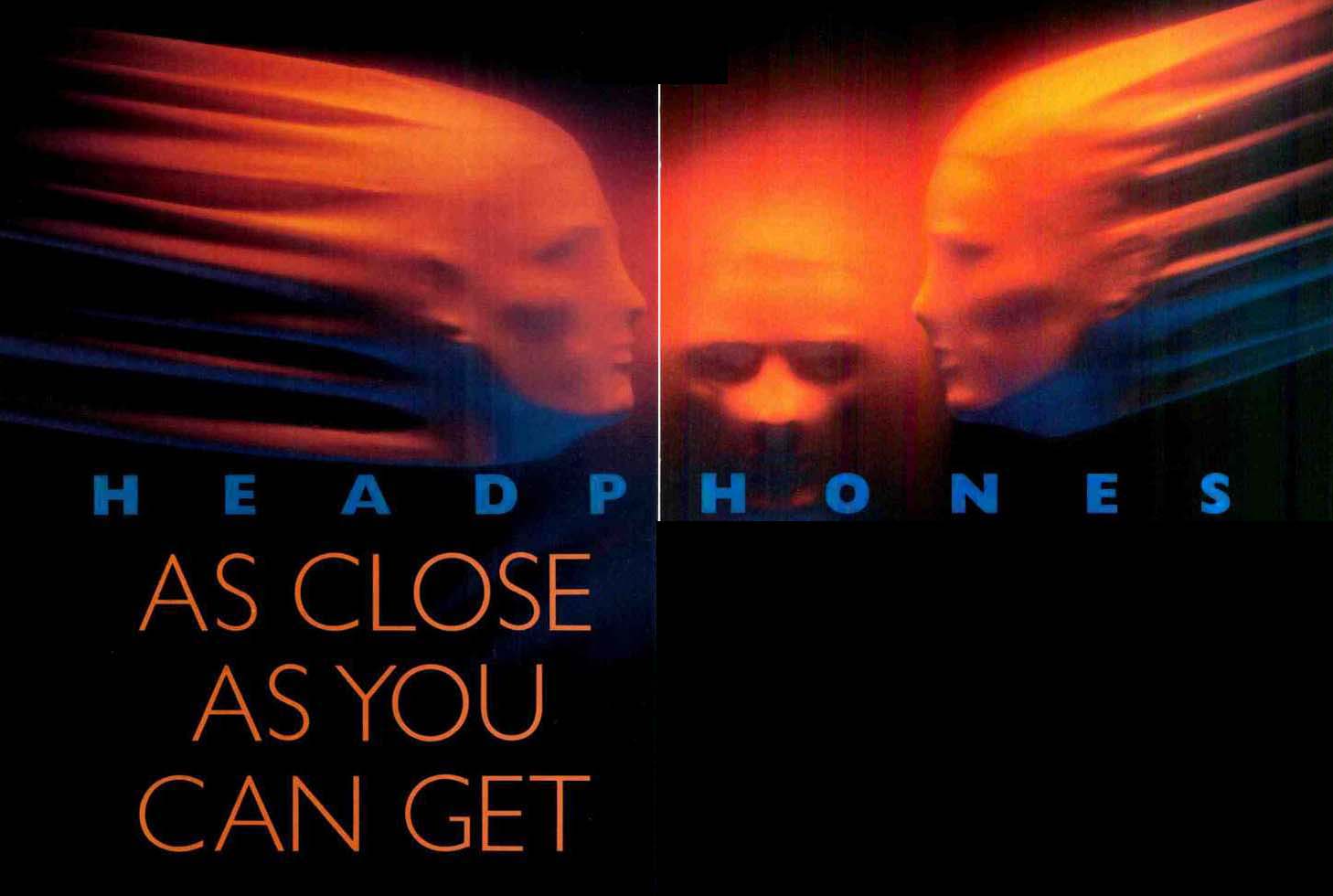
by EDWARD M. LONG
Listening with headphones can probably bring you as close as you can get to hearing exactly what is on a recording or what is being broadcast over the radio or TV. I say probably because, while the potential is there, all headphones have their own limitations and none are capable of providing deal performance. In this article, I will attempt to show why this is true and also why it is so difficult to obtain measurements on headphones that correlate well with subjectively perceived performance. I will then show how I propose to overcome these difficulties so as to give you some idea about how headphones perform. (I should also mention that I often use the term "earphone" rather than "headphone" when discussing them; "earphone" covers a wider variety and includes over-the-ear and in-the-ear types, whereas "headphone" tends to connote only over-the-ear types.)
Some of the factors that affect earphone testing are the effects produced by the outer ear (which includes the pinna, concha, and ear canal), the directional effects produced by the sound field, and the method used to produce the program material to which you will be listening. Figure 1, a diagram of the outer ear, shows the major parts I will be discussing.
The outer ear produces a resonance that has a maximum at about 2,800 Hz; this causes an increase in the sensitivity of the ear of about 15 dB. Figure 2 shows the average of the sound pressure versus frequency measurements on 16 real human ears, made with a probe microphone placed near the eardrum, which verifies this effect of the outer ear. This should come as no surprise to anyone who has ever seen a set of hearing versus sound pressure level (SPL) curves. (These curves are also known as the Fletcher Munson curves after the men who first published them.) Figure 3 shows a set of curves for the perceived loudness, in phons, at different sound pressure levels; these curves are normally used to show the change in sensitivity of the ear in the lower frequency range for different sound pressure levels. The point I wish to make is that in each of these curves the maximum sensitivity of the ear, at any SPL, is at about 3 kHz. Don't be confused by the fact that Fig. 2 and Fig. 3 seem to be the reciprocals of each other; remember that Fig. 2 shows the increase in sensitivity of the ear at this resonance, while Fig. 3 shows that the perceived threshold level is lower for sounds at this frequency. More recent studies, dealing specifically with earphone and hearing-aid research, have expanded our knowledge of the outer-ear resonance effect. The question arises then: Should I find some way to include this effect when measuring earphones? Should I try to build an equalizer for it? I don't include it when measuring loudspeakers, but remember, earphones can be of the in-the-ear type and this outer-ear resonance may be affected by their placement in or near the listener's ear canal.
Should I also include the possible variations in the effects produced by the pinna or concha when different types of earphones are placed on or around them? The pinna is responsible for much of our ability to determine the direction from which sounds arrive at the ear. What happens to this direction-finding function when the earphone is located close to the pinna or, worse yet, when it is placed directly in the ear, essentially short-circuiting the pinna and its effects? The pinna also has its own resonance-producing cavities or folds as well as "shadowing" effects; how are these affected by earphone placement? Should I try to compensate for these effects in the measurement by the use of some equalizing circuitry? Figure 4 is a diagram for an artificial ear made by B & K which has long been used to test earphones; its major application has been the testing and calibrating of audiometric headphones used for evaluating hearing loss. Although it has been designed with a cavity that is intended to duplicate the acoustical effect produced by the canal of a real ear, it does not try to duplicate the effects of a pinna. I have one of these B & K Model 4153 artificial ears in my laboratory, but I decided not to use it because it has not been fully agreed on as a standard and because it has some obvious limitations when you think of the broad range of different earphone types available.
One of the ways that the pinna helps to determine the direction from which a sound reaches the ear is that it produces different acoustical responses for sounds arriving from different angles. Some recordings have been made that take advantage of this characteristic of all ears to produce sounds which seem to move up and down as well as across the space between loudspeakers, thus fooling the ear.
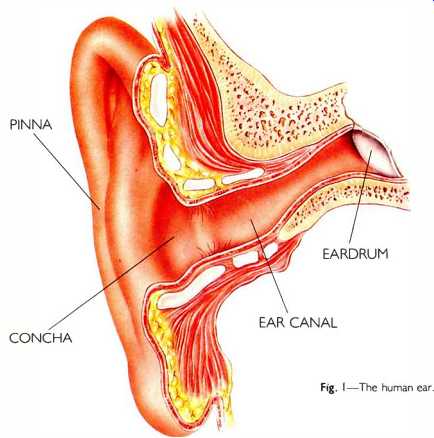
Fig. 1--The human ear.
This is done by dynamically changing the shape of the sound spectrum while the sound is "panned" from one channel to the other. Also, have you ever noticed that when people are really concentrating on something they wish to hear, they lower their head slightly and turn one ear a little in the direction of the sound source? This is because the response of the ear changes with the direction of the incident sound and appears to be best when it comes from a point slightly up and to the side of the head. How can I take this into consideration when measuring earphones? It is a fact that the acoustics of the listening environment can produce a different subjective response to a sound, whether that sound is produced by a "live" source or reproduced by loudspeakers. The same sound can be perceived as very bright and sharp when you hear it in a hard surfaced, reverberant room, or very dull and dry when you are listening outdoors. Some of this effect will be due to the way the sound arrives at the pinna. In a reverberant room, the sound will come from many directions; besides the sound coming from the direction of the original source, there will be sounds that reach the ear from other directions as well. This is because, if you are in a reverberant environment, the sound will be reflected from surfaces to the sides, above, and even behind you. Depending on the direction from which these sounds arrive at the ear, the characteristics of the pinna and concha will cause their amplitude versus frequency spectrum to have a different shape, with an increase of total perceived energy in the mid-frequencies. The result of the sounds coming from different directions is to make the sound seem bright.
In a free-field or anechoic environment, the sound will come only from the direction of the sound source, with no added energy from other directions to "enhance" its spectral content; thus it will seem duller. If the listening environment can change the perceived spectrum of the sound, how can I make provision for this when I test and evaluate earphones?
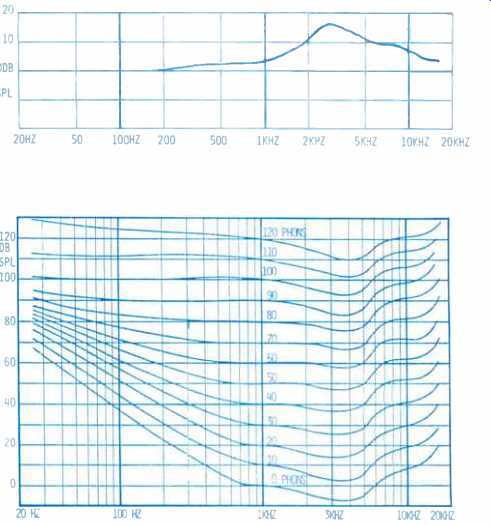
top: Fig. 2--Average sound pressure level measured at eardrums of 16 people.
above: Fig. 3--Sound pressure levels required for various perceived loudness
levels (in phons), at various frequencies. The ear is most sensitive at around
3 kHz.
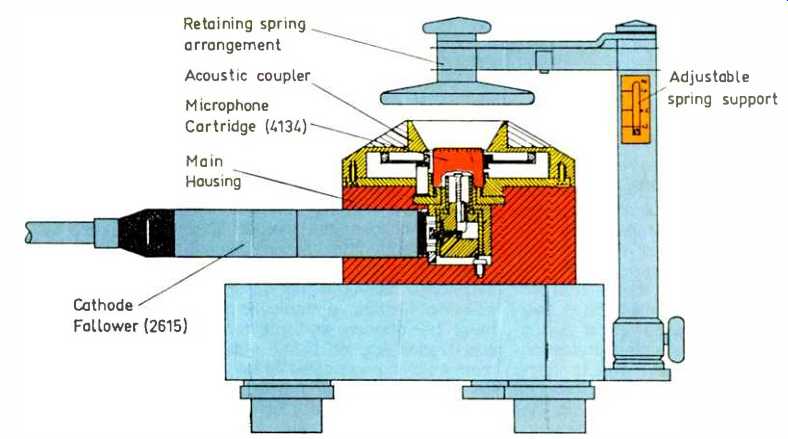
Fig. 4--Brüel & Kjaer Type 4153 Artificial Ear, used widely for testing
audiometric (rather than consumer) earphones.
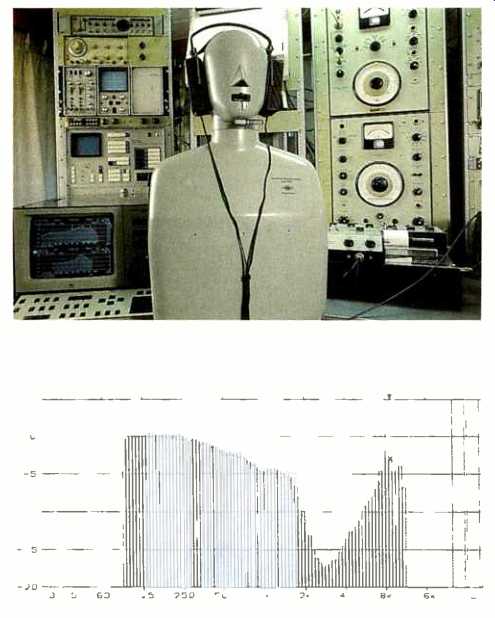
top: Fig. 5--Brüel & Kjaer Head and Torso Simulator (HATS), with headphones
in place. above: Fig. 6--B & K HATS correction curves for free-field (vertical
bars) and diffuse-field measurement.
When you consider that the pinna and the sound field definitely interact in a way that changes the frequency spectrum of the sound pressure at the eardrum, you will probably conclude that measurement technique should probably include some way to handle this. The problem is compounded if you consider that most researchers agree that all pinnae are different; no two ears are the same. So what am I to do, now that you know that a "standard ear" is not only not available but could be the food for another great debate? Recordings have been made which purport to be ideal for earphone listening; such "binaural" recordings include those made with closely spaced microphones or microphones in a dummy head: There are a variety of dummy-head recordings, with the microphones located either down inside the head, at the bottom of artificial ear canals, or directly in the side of the head (with or without artificial ears). These recordings, since there are so many unknowns about them, usually leave something to be desired. Part of the problem, even in the best recordings where all the details have been considered and accounted for by conscientious and dedicated professionals, may be the result of substituting someone's idea of the ideal pinna and concha for yours. It may just be that your own reference ears will never allow you to be convinced that the "standard ears" used to make the recording are the same as yours. Some artificial-ear recordings have been equalized to account for the outer ear resonance, but those "standard pinnae" are still there.
There is also some disagreement among the experts as to how to compensate, in a standard earphone measurement, for the fact that the response of even a "standard ear," if they could agree on what that standard would be, would be different for sounds arriving from different directions. This is known in the earphone business as the "free field versus diffuse field" argument. As described previously, free field means that the environment has no surfaces that could reflect sound and the sound will arrive at the ear from only one discrete angle. This means that, to standardize earphone measurements using the free-field method, a particular angle must be chosen and appropriate equalization applied to the measurement which compensates for the spectral shaping effects that would be caused by a "standard ear" when it received sounds from that angle in a real free field. The angle usually chosen is 00 incidence angle, or directly in front of and in the same horizontal plane as the ear. As I said earlier, most people usually lower and tilt their heads when listening intently, so this may not be the best angle after all.
Another argument against a totally free-field type of measurement standard is the fact that most people who have had the opportunity of listening to speech and music in an anechoic chamber do not think that it sounds very natural.
The diffuse-field argument assumes that the environment causes energy to arrive from all possible angles as well as directly from the source, which leads to the idea of averaging everything into one measurement and applying appropriate average equalization to compensate for the effects of a "standard ear." Since most reverberation chambers are not the kind of place that one would like to listen to speech or music, I have my doubts about this method being the ultimate answer. The proponents of these alternate ways of measuring earphones put forth strong arguments for their cases, but I am not convinced that either side has all the answers. Research has also shown that the range above about 8 kHz is really problematical as far as earphone measurements are concerned, and I have found no consensus about what to do about the variations in response in this range; most audiological testing and calibration focuses on the range below 8 kHz because of many factors, mainly due to standing waves, which affect measurements made above this frequency.
Brüel and Kjaer has recently brought out a manikin for use in testing earphones, microphones, etc., nicknamed "HATS," an acronym for Head and Torso Simulator. Figure 5 is a photo of the HATS unit in my laboratory, with a set of earphones in place over the artificial ears. Rather than taking sides in the debate over whether free-field or diffuse-field measurements are best, B & K supplies various equalization curves and calibration data on a 3 1/2 inch floppy disk which can be used with the B & K 2133 Frequency Analyzer. The equalization can be used to compensate for either the free-field or diffuse-field characteristics of the manikin. These correction curves are shown in Figure 6. The diffuse-field correction is milder than the free-field correction. I made measurements on different types of earphones using "HATS" as part of this investigation into the state of the art of headphone evaluation. While I think that it has some real potential as a design and development tool, I am not certain how well it may serve the purpose for which I would like to use it, i.e., presentation of graphical data that correlates well with perceived sound quality. I am not saying that it could not be done or that there is any device that performs better, just that there may be a simpler way to present and correlate technical measurement information with what we hear, at least to some degree, until standards can be agreed on.
As an example of the problem, made a set of measurements of the Stax SR-Lambda Professional electrostatic Earspeaker (as it is called), shown in Fig. 7. The curves made with the B & K HATS free-field and diffuse-field equalization both seem to show inadequate compensation for the outer ear resonance effects. Stax has made available a Model ED-1 diffuse-field equalizer for the Lambda Pro that has a different compensation curve than does the B & K "HATS"; the latter is intended to produce a flat amplitude versus frequency curve. The problem boils down to this: Each individual manufacturer still sets its own goal since there are no standards.
Even if we can generate meaningful measurements that can be correlated to what we hear, I still believe in having a listening panel audition products and gathering their written comments. I will then try to correlate what they perceive with technical measurements. The technical measurements will be made before the listening sessions so that I can make certain that the product does not have any serious defects and that there are no interface problems in the system. I also decided that, for the evaluation of earphones, it would be a good idea to have a set of standard earphones against which comparisons could be made. I chose the Stax SR-Lambda Professional electrostatics for a number of reasons, the most important of which was the long-lime general consensus that they are arguably the best that are widely available. This gives the reader of any earphone report a chance to hear the same Stax reference earphones with SRM-1/MK-2 drive electronics and make his own comparisons. This is possible with earphones because there are none of the deleterious listening environment or interface effects that are always present when trying to audition other audio components. With earphones you are "as close as you can get."
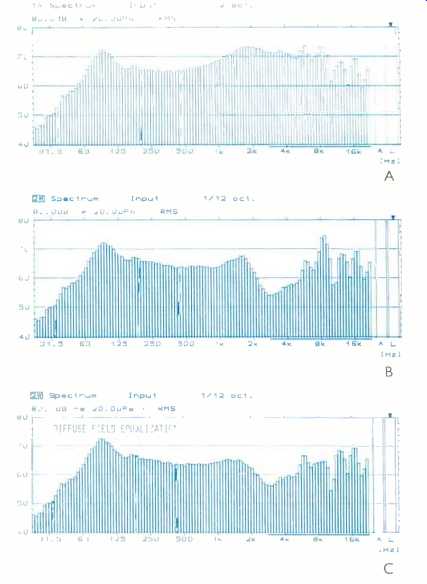
Fig. 7--Response of Lambda Pro electrostatic Ear speaker measured without
equalization (A), measured with B & K HATS free field equalization (B),
and measured with B & K HATS diffuse field equalization (C).
To show the tests I finally settled on, I refer you to the Lambda Professional Earspeaker report to follow. Since these tests will be standard, at least for a while, I hope that you find the report useful and informative. I would like to thank Mead Killion of Etymotic Research for his helpful comments and suggestions. If you have any comments or suggestions of your own, please let me know. If you are interested in earphone research and testing, please check the accompanying list of articles on earphones.
REFERENCES
1. Werner, Erhard, "Headphones-Still a Lot of Questions," AES Preprint No. 2212 (March 1985).
2. Thiele, Gunther, "On the Standardization of the Frequency Response of High Quality Headphones," Journal of the Audio Engineering Society, Vol. 34, No. 12.
3. Shaw. E. A G., "Ear Canal Pressure Generated by a Free Sound Field," Journal of the Acoustical Society of America, Vol. 39, No. 3.
4. Shaw. E. A. G., "Ear Canal Pressure Generated by Circumaural and Supraaural Earphones," JASA, Vol. 39, No. 3.
5. Munson, W. A. and Francis M. Wiener, "In Search of the Missing 6 dB," JASA, Vol. 24, No. 5.
6. Shaw, E. A. G., "Hearing Threshold and Ear-Canal Pressure Levels with Varying Acoustic Fields," JASA, Vol. 46, No. 6 (Pt. 2).
7. Shaw, E. A. G. and R. Teranishi, "Sound Pressure Generated in an External-Ear Replica and Real Human Ears by a Nearby Sound Source," JASA, Vol. 44. No. 1.
8. Schroeder, Manfred R., "Models of Hearing," Proceedings of the IEEE. Vol. 63, No. 9.
9. Committee on Hearing, Bioacoustics, and Biomechanics, "Earphones in Audiometry," JASA, Vol. 83, No. 4.
10. Stevens, K., R. Berkovitz, G. Kidd, and D. Green, "Calibration of Ear Canals for Audiometry at High Frequencies," JASA, Vol. 81, No. 2.
11. Wightman, Frederic and Doris Kistler, "Headphone Simulation of Free-Field Listening, Part I: Stimulus Synthesis," JASA, Vol. 85, No. 2.
12. Wightman, Frederic and Doris Kistler, "Headphone Simulation of Free-Field Listening, Part II: Psychophysical Validation," JASA, Vol. 85, No. 2.
13. Stelmachowicz, P., K. Beauchaine, A. Kalberer, W. Kelly, and W. Jesteadt. "High-Frequency Audiometry: Test Reliability and Procedural Considerations," JASA, Vol. 85, No. 2.
14. Lindevald, I. M. and A. H. Benade, "Two-Ear Correlation in the Statistical Sound Fields of Rooms," JASA, Vol. 80. No. 2.
15. Tohyama, Mikio and Akira Suzuki, "Interaural Cross-Correlation Coefficients in Stereo-Reproduced Sound Fields," JASA, Vol. 85, No. 2.
16. Johnstone, B. M. and K. J. Taylor, "Use of Probe Microphones to Measure Sound Pressures in the Ear," JASA, Vol. 46. No. 6 (Pt. 1).
17. Shaw, E. A. G., "Hearing Threshold and Ear-Canal Pressure Levels with Varying Acoustic Field," JASA, Vol. 46, No. 6 (Pt. 2).
18. Speaks, Charles, "Effect of Circumaural Earphone Cushions on Threshold Sensitivity for Speech," JASA, Vol. 46, No. 6 (Pt. 2).
19. Thomas, M. V., "Improving the Stereo Headphone Sound Image," JAES, Vol. 25, No. 7/8.
20. Wilson, J. P., "High-Quality Electrostatic Headphones," Wireless World, Dec. 1968.
58. Lirpa, I., "Confessions of a Very Tired and Cross-Eyed Typist," Autobiography of Ms. K. Blumenthal, Part III: The Middle-Aged Years, Vol. 4191, Rev. No. 9.
21. Cohen, Abraham B., "The Real World of Headphone Performance," AES Preprint No. 626 (Oct. 1968).
22. Long, Robert, "New Designs in Headphones," High Fidelity, Feb. 1970.
23. "Stereo Headphones," Consumer Reports, Oct. 1967.
24. Silverman, Leigh, "Loud Music and Hearing Loss," Audio, Jan. 1989.
25. Villchur, Edgar, "Free-Field Calibration of Earphones," JASA, Vol. 46, No. 6 (Pt. 2). 26. Tappan, Peter, "Nearphones ... A Far Out Idea?" Audiofan, Jan. 1965.
27. Bauer, Benjamin B., "Stereophonic Earphones and Binaural Loudspeakers," JAES, Vol. 9, No. 2. 28. Larson, Robert and John Eargle, "A Headphone Control Center for Monaural. Diotic and Binaural Listening," Audio, Nov.1962.
29. Harvey, F. K., J. G. Gisek, D. J. Maclean, and M. R. Schroeder, "Some Aspects of Stereophony Applicable to Conference Use." JAES, Vol. 11, No. 3.
30. Bauer, Benjamin B., "Improving Headphones Listening Comfort," JAES, Vol. 13, No. 4.
31. "Toneburst" (author), "Towards True Stereophony: A Practical Headphone System," Wireless World, Sept. 1969.
32. Kürer, R., G. Plenge, and H. Wilkens, "Correct Spatial Sound Perception Rendered by a Special 2-Channel Recording Method," AES Preprint No. 666 (Oct. 1969).
33. Damaske, P. and B. Wagener, "Directional Hearing Tests by the Aid of a Dummy Head," Acustica, Vol. 21, No. 1.
34. Schirmer, W., "Die Richtcharakteristik Des Ohres (The Directional Characteristics of the Ear)." Hochfrequenztech u. Elektroakustik. Vol. 72.
35. Stark, Craig, "The Sense of Hearing," Stereo Review, Sept. 1969
36. Wollheim, William, "Understanding Headphones," Stereo Review, Dec. 1969.
37. White, James V. "Considerations in High-Fidelity Moving-Coil Earphone Design," IEEE Transactions on Audio, Nov./Dec. 1963.
38. Shaw, E. A. G. and G. J. Thiessen, "Acoustics of Circumaural Earphones," JASA, Vol. 34, No. 5 (Pt. 1).
39. Boomsliter, Paul and Warren Creel, "Hearing with Ears Instead of Instruments." JAES, Vol. 18. No. 4.
40. Brüel, V., Erling Frederiksen, and Gunnar Rasmussen, "Artificial Ears for the Calibration of Earphones of the External Type, Part I," B & K Technical Review, No. 4, 1961.
41. Brüel, V., Erling Frederiksen, and Gunnar Rasmussen, "Artificial Ears for the Calibration of Earphones of the External Type, Part II," B & K Technical Review, No. 1, 1962.
42. Glaser, J. L. and K. C. Morrical, "A Comparison of Artificial Ear Couplers," JASA, Vol. 20, No. 6.
43. Morrical, K. C., J. L. Glaser, and R. A. Benson, "Interactions Between Microphones, Couplers and Earphones," JASA, Vol. 21, No. 3.
44. Burkhard, M. D. and E. Corliss, "The Response of Earphones in Ears and Couplers," JASA, Vol. 26, No. 5.
45. Sergeant, Russell L. and J. Donald Harris, "Supra-Aural Cushions in Audiometry." JASA, Vol. 33, No. 7.
46. Stein, Laszlo and Stanley Zerlin, "Effect of Circumaural Earphones and Earphone Cushions on Auditory Threshold," JASA, Vol. 35. No. 11.
47. Tillman, T. W. and K. D. Gish, "Comments on the Effect of Circumaural Earphones on Auditory Threshold," JASA, Vol. 36, No. 5.
48. Ithell, A. H., E. G. T. Johnson, and R. F. Yates, "The Acoustical Impedance of Human Ears and a New Artificial Ear," Acustica, Vol. 15, No. 2.
49. Charan, K. K., J. R. Cox, and A. F. Niemoeller, "Evaluation of New Couplers for Circumaural Earphones," JASA, Vol. 38, No. 6.
50. Benson, R. W., K. K. Charan, J. Day, et al., "Limitations on the use of Circumaural Earphones," JASA, Vol. 41, No. 3.
51. "Electronic 'Earmuffs,'" Electrical Engineering, Dec. 1958.
52. Toole, Floyd E., "The Acoustics and Psychoacoustics of Headphones, AES Preprint No. C1006 (May 1984).
53. Campbell, R. H., "On the Objective Testing of Circumaural Hearing Protectors," AES Preprint No. 648 (May 1969).
54. Gierlich, H. W., and K. Genuit, "Processing Artificial--Head Recordings," JAES, Vol. 37, No. 1/2.
55. Altshuler, Mort, "Balanced Attenuation Ear Protection," Sound & Communications, March 1989.
56. Tappan, Peter, "Proximaural Loudspeakers ('Nearphones')," AES Preprint No. 358 (Oct. 1964). 57. Amplatz, Kurt, "The 'Humanized' Headphone," AES Preprint No. 531 (Oct. 1967).
(Source: Audio magazine, Apr. 1991)
Also see:
The New Featherweight Headphones (May 1981)
Headphones: History and Measurement (May 1978)
Headphones around the house (May 1974)
Illusions for Stereo Headphones (Mar. 1987)
= = = =